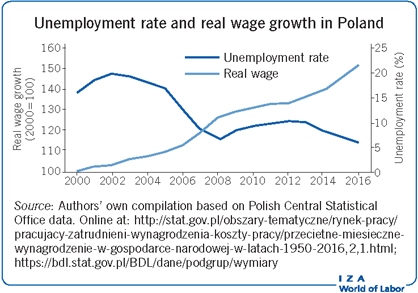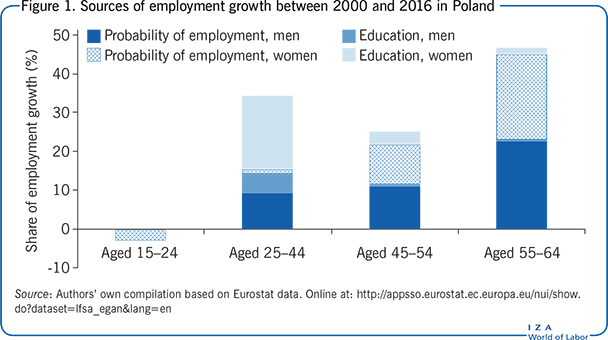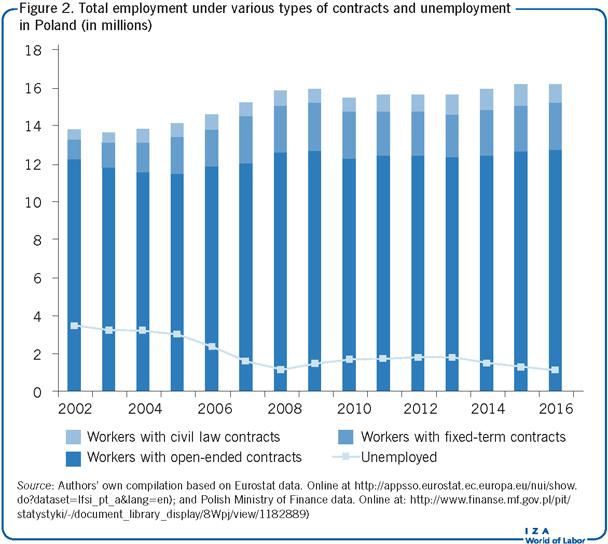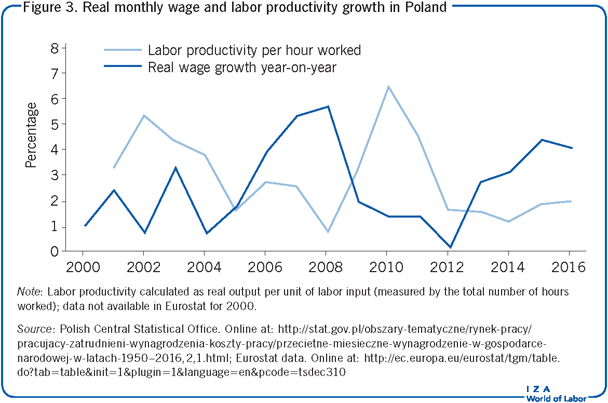Elevator pitch
In the early 2000s, Poland’s unemployment rate reached 20%. That is now a distant memory, as employment has increased noticeably and the unemployment rate has dropped to 5%. However, most of the net job creation has consisted of temporary jobs. Labor market segmentation has become an issue and an important factor behind wage inequality. Labor force participation of older workers increased after reforms aimed at prolonging careers, but the recent reversal of the statutory retirement age leaves Poland vulnerable to the effects of population aging.

Key findings
Pros
The employment rate for those aged 15–64 increased significantly between 2000 and 2016, while the unemployment rate declined noticeably over the same period.
Long-term unemployment dropped by ten percentage points between 2003 and 2016.
In 2016, the labor force participation of older workers reached its highest level since 1990.
Real wages increased by 54% between 2000 and 2016.
Real wage growth was the highest at the bottom of the wage distribution, and earnings inequalities have not changed much since the early 2000s.
Cons
Temporary employment has more than doubled since 2000, and Poland now has the highest share of temporary employment in the EU.
Labor force participation of older workers remains low in comparison to most developed countries.
The reduction of the retirement age in 2017 exacerbates the decline in labor supply resulting from population aging.
The gender pay gap remains high, especially after adjusting for differences in personal characteristics.
The total compensation of employees as a percentage of GDP is one of the lowest in the EU.
Author's main message
The Polish labor market is booming: the employment rate is historically high and the unemployment rate has dropped to a record low level. Since 2000, wage growth has accelerated and inequality has declined as the minimum wage has risen. However, the increase in the share of temporary jobs to more than 20% has not been fully addressed by policymakers. Moreover, labor force participation remains relatively low, and the rapidly aging population will further reduce labor supply. Future policy measures should thus include improving employment protection for all workers, reducing the tax burden on low-paid workers, and once again raising the retirement age.
Motivation
In the early 2000s, Poland had one of the highest unemployment rates among current EU member states. Robust employment growth starting in 2004 and the country’s resilience to the Great Recession changed the labor market outlook dramatically. In 2016, the employment rate was at a record high level, while the unemployment rate was only 5%. However, there are important cracks in this positive picture. Labor’s share of national income (the total compensation of employees as a percentage of GDP) is one of the lowest in the EU, despite a recent acceleration in wage growth. Job quality is also an issue, mainly because of the large share of temporary contracts. Finally, relatively low labor force participation contributes to labor shortages, which will be aggravated by a shrinking working-age population in the years to come. The reforms introduced between 2009 and 2013 aimed at postponing retirement seem to have been successful, as they were followed by an increase in participation and employment among older workers; however, the policy course has since been changed, with the retirement age being lowered in 2017. Overall, Poland presents an instructive example of a post-communist economy’s successes and challenges.
Discussion of pros and cons
Unemployment and employment developments
The labor market situation in Poland improved perceptibly between the early 2000s and the mid-2010s. After unemployment for those aged 15–64 reached a record high of 20.2% in 2002, it declined rapidly to a historically low level of 7.2% in 2008. The 15–64 age group provides a more informative picture than the 15–74 age group used as a default by Eurostat, given the (changing) structure of retirement incentives in Poland.
The Great Recession had a moderate impact on the Polish economy, which only experienced a slowdown in economic growth in 2009–2010. The unemployment rate rose to 10.5% in 2013, about half of the previous peak recorded during the 2001–2002 downturn. Since 2014, the unemployment rate has again declined quite quickly, reaching 5.5% in 2016—its lowest level since the transition to a market economy in 1989. In absolute terms, unemployment in Poland declined from its highest point of 3.4 million people in 2002 to 1.1 million in 2016. The incidence of long-term unemployment (more than 12 months) has also shrunk. From 2001 to 2007, the long-term unemployment rate averaged 9.3%, and between 2002 and 2005 it exceeded 10%. From 2008 to 2016, the long-term unemployment rate never surpassed 5%, averaging 3.2% over this period—well below the EU average of 4.2%.
The reduction of unemployment was largely driven by employment growth. Since 2004, after a period of severe stagnation in the labor market resulting from the Russian financial crisis in 1997 and the economic slowdown of 2001–2002, employment in Poland has been growing vibrantly. The employment rate increased from 51.7% in 2004 to 59.2% in 2008, remained flat during the Great Recession, and then rose further to 64.5% in 2016.
Three features of recent employment growth in Poland are worth mentioning. First, the rising tertiary education attainment of labor market entrants translated into a noticeable educational upgrading of the workforce—the employment share of college graduates rose from 13.9% in 2000 to 33.6% in 2016. Second, the employment rate of older workers increased conspicuously, especially after 2006. Between 2000 and 2016, the employment rate of the population aged 15–64 increased by 9.3 percentage points (pp). Of this increase, 2.8 pp (30%) can be attributed to changes in the educational structure of the workforce, especially among prime-aged women, while 5.3 pp (70%) can be attributed to the increase in probabilities of employment, especially among people aged 45–64 (Figure 1). The increase in older workers’ employment rates is related to the increase in labor force participation among these groups, as will be discussed below.

Third, temporary employment, including work under fixed-term contracts, temporary work agencies, and the so-called “civil law contracts,” skyrocketed. Between 2002 and 2016, the number of workers with temporary contracts more than doubled (Figure 2). Because of changes in the Polish Labor Force Survey, temporary employment in Poland can be analyzed in a consistent manner only from 2002 onwards. Of the 2.4 million total net jobs created between 2002 and 2016, 2.0 million were temporary jobs. In 2012, Poland surpassed Spain to have the highest share of temporary jobs in the EU (over 20% of total employment in 2014–2016) Two stages of temporary employment growth in Poland can be distinguished. Between 2002 and 2008, temporary employment increased by 1.7 million workers, primarily because of inflows of previously jobless people. Between 2008 and 2016, the total growth in temporary employment slowed considerably, with an increase of an additional 250,000 temporary workers. In this latter period, temporary employment grew mainly because temporary workers were increasingly stuck in these contracts, and their flows to permanent jobs subsequently declined, leading to increased labor market segmentation. People aged 20–39, and those with primary, basic vocational, and secondary educational levels have been overrepresented among temporary workers [1], and most temporary jobs were taken involuntarily because workers could not obtain permanent contracts [2]. The high incidence of temporary contracts has thus replaced unemployment as the main labor market concern in Poland.

In contrast to countries like Spain, the rise of temporary employment in Poland was not preceded by any substantial deregulation of the rules pertaining to temporary contracts, nor by any increase in the regulation of permanent contracts. However, there was a general movement toward less strictly regulated employment protection. In the early 2000s, the rules on collective dismissals were loosened and a more liberal law on temporary work agencies was introduced. The rise of outsourcing, including in the public sector, was associated with the use of a casual form of contract: civil law contracts. These contracts have not been covered by the labor code (and as such offer no protection against dismissal). Moreover, they have not been covered by the minimum wage, and have different rules pertaining to social security—less coverage and lower contribution payments than implied by employment contracts.
A raft of changes increasing the regulation of temporary contracts has recently been introduced. In 2016, a maximum total duration of fixed-term contracts was set, stricter limits on their renewal were introduced, and dismissal notice periods were equalized with those pertaining to open-ended employment contracts. However, fixed-term contracts can still be terminated by employers without justification (contrary to open-ended contracts). In 2016, the minimum social security contributions pertaining to civil law contracts were increased, and in 2017 an hourly minimum wage covering these contracts was enacted. However, civil law contracts are still not covered by any protection against dismissals. In 2015–2016, the total number of temporary jobs stopped growing and the number of permanent jobs increased, but it is unclear to what extent this can be attributed to changes in regulation versus the overall improvement in labor market conditions.
Labor force participation developments
Labor force participation in Poland has been relatively low compared to other EU countries—between 2000 and 2016, the participation rate among those aged 15–64 ranged from 64% (2005–2009) to 68% (2014–2016). Participation of older workers and prime-aged women has been a particular concern. However, participation among these groups has increased since the middle 2000s, especially among older workers. From 2001 to 2006, the participation rates of people aged 55–64 averaged 30% (only 21% among women) and were among the lowest in Europe. In 2014–2016, they increased to an average of 47% (58% among men, 37% among women), which is significant, though still ranks low compared to most developed countries.
Two major reforms aimed at extending the typical working lifespan have been introduced in Poland over the last ten years [3]. The first reform, implemented in 2009, eliminated the early retirement system (introduced in 1983) that had allowed workers in a wide range of professions to retire before reaching the statutory retirement age. In most cases, a worker could take early retirement up to five years before reaching the statutory retirement age. Thus, a woman could retire at age 55 and a man could retire at age 60. In some professions, however, workers could retire at even lower ages. The 2009 reform replaced the early retirement system with the so-called “bridging pension system,” which covered a much narrower range of professions with much more restrictive conditions for accessing early retirement. The 2009 reform mainly affected men born after 1948 and women born after 1953.
The second crucial reform was implemented in 2013. Since then the statutory retirement age has gradually increased by four months per year, starting with men born in 1948 and women born in 1953. The target age of 67 was supposed to be reached in 2020 for men and in 2040 for women. However, this reform was recently repealed by a law that reduced the retirement age back to 60 for women and 65 for men, which came into effect from October 1, 2017 onwards.
In the wake of these reforms, the labor force participation rates of the affected cohorts increased. Although the overall improvement in labor market conditions may also have contributed to rising participation of older workers, there is evidence that cohorts affected by the reforms recorded a stronger increase in participation than those not affected [4]. Higher labor force participation rates translated into higher employment rates, while the unemployment rate of workers aged 55–64 remained below the total unemployment rate, and declined to as low as 4.4% in 2016. Employment rose because older people stayed in their jobs. The retention rate—or the share of workers aged 55–59 who remained employed in the same job after 60—doubled between the early 2000s and the early 2010s. However, the reduction of the retirement age implemented in 2017 will put a hold on employment rate growth among older workers.
Since the early 2000s, Poland has recorded a slight decline in participation of prime-aged women, which contrasts with rising female participation across Europe. Access to childcare has been relatively low, although improving, while both maternity and parental leave as well as financial transfers directly to mothers have been expanded. The introduction of the Family 500+ program in 2016—an unconditional cash transfer of 500 PLN per month for every second and subsequent child under the age of 18—was a key change in family policy. This benefit is also granted for the first child under 18 if the net monthly per capita income of a family is lower than 800 PLN (or 1,200 PLN in the case of a child with a disability). Moreover, the Family 500+ program does not affect people’s eligibility to any other benefits, nor does it count as income for other means-tested benefits and allowances. The program aims at improving the living standards of families, but may also affect labor supply, primarily of women.
Finally, after EU accession in 2004, the labor supply in Poland declined by more than one million people due to international migration. These economic migrants were relatively young and moved mainly to the UK, Germany, the Netherlands, Ireland, and southern EU countries. This outflow eased the oversupply of labor in the middle 2000s, but in the 2010s it aggravated labor shortages, which have recently triggered an inflow of Ukrainian workers.
Real wage developments
Real wage growth stagnated in the early 2000s, reflecting poor labor market conditions and high unemployment (Figure 3). As the labor market started to recover in 2004, wage growth accelerated to over 5% in 2006 and 2007. It slowed down in the aftermath of the Great Recession before increasing in 2013 and again exceeded 4% in 2016. Upward wage pressure is likely to intensify further, following growing productivity, a substantial decrease in unemployment, and minimum wage hikes. Still, since 2000, the cumulated real wage growth (54%) has been slightly lower than the cumulated productivity growth (60%, measured per hour worked). The gap between productivity and wage growth widened in particular during the slowdown in the early 2000s and the Great Recession. Overall, wages in Poland remain relatively low compared to productivity. Labor’s share of GDP amounted to 37% in 2016, well below the EU28 average of 47.5% and that in most other Central and Eastern European countries.

Earnings inequality
Earnings inequality in Poland is greater than in most EU countries, with the top 10% of earners receiving 4.6 times more than the bottom 10% in 2014, the most recent year for which data on this issue are available. Inequality is greater above the median wage (the 90/50 percentile income ratio was 2.5 in 2014) than below it (the 50/10 percentile income ratio was 1.85 in 2014). A high wage premium for higher education and labor market segmentation are key factors behind this earnings inequality [5]. Wage disparities increased in the early 2000s, but declined after 2006. In 2014, overall wage inequality was close to the level recorded in 2000, although it was higher above and lower below the median. Since the early 2000s, the cumulated growth of real wages was the highest at the bottom of the wage distribution (52% in the first decile, 27% in the second decile), and uniform above the 20th percentile of wage distribution (22%).
Changes in the minimum wage have been an important factor affecting wage growth and the wage distribution, especially since 2007. Between 2000 and 2007, the minimum wage amounted to 36% of the average wage each year, but following a series of hikes introduced after 2007, it reached 46% of average wages in 2016. In real terms, the minimum wage was increased by 66% between 2007 and 2016. The share of minimum wage earners increased from 14.9% in 2014 to 16.4% of eligible workers in 2015 [6]. There is evidence that these minimum wage hikes were associated with higher wages among low-skilled workers, but also with job losses, in particular among youth, women, and workers with temporary jobs [7]. Minimum wage hikes were followed by increasing non-compliance: in 2003–2007, on average 3.7% of eligible full-time workers were underpaid; by 2011–2012, this share rose to 5.8% [8].
Gender gaps
In 2014, women earned on average 94% of men’s hourly wages, a level similar to that observed in the early 2000s. While the average pay gap between men and women is relatively low in Poland compared to the other EU countries, the adjusted pay gaps (accounting for differences in individual characteristics of men and women, such as their age, education, or experience) show large gender wage inequality [9]. In the last decade, adjusted pay gaps have not fallen below 15%, despite the fact that a range of factors should have benefited women (e.g. higher share of graduates among women, falling fertility rates, increased childcare coverage, anti-discrimination policies). The gender pay gaps in Poland have been pro-cyclical—they narrowed during economic slowdowns and worsening labor market conditions, and widened during booms. The gaps tend to increase with age until 30–39 years, and decline among older age groups. This age pattern may reflect the selection of older men and women into employment because of early retirement provisions (until 2008), with a lower retirement age allowing women to withdraw from the labor force five years earlier than men and lower-paid workers being more likely to have taken advantage of this possibility. It may therefore change in the future, as the labor force participation of older women increases.
Limitations and gaps
The labor market consequences of the recently introduced generous family benefit program Family 500+ remain largely unknown. Ex ante simulations show that the benefit increased financial disincentives to work among parents, resulting in a strong labor supply disincentive effect. Early results point to an outflow of mothers to inactivity. Yet, more thorough research and policy evaluation are needed.
There are important gaps in the data on the use of civil law contracts, making it difficult to investigate this segment of the temporary jobs market and its development over time. Moreover, the unavailability of data also restricts understanding about the role of immigration flows into Poland, primarily from Ukraine. These flows have increased substantially over the past three years, but the available estimates of the size of the immigration stock and flows, and the data on the composition of migrants and their workplaces, remain fragmented.
Summary and policy advice
The Polish labor market has experienced an impressive turnaround beginning in the early 2000s. The employment rate increased and the unemployment rate fell dramatically, although labor market segmentation emerged. Some regulatory steps aimed at discouraging the excessive use of temporary contracts have recently been taken, but more effort is needed on this front. Gaps in the regulation of permanent contracts, as well as fixed-term and civil law contracts, should be reduced. So-called “single contracts” that relate the degree of employment protection for all workers only to their tenure could be a step forward. In addition, Poland should reduce the tax burden on low-paid workers, which is very high in comparison to other EU countries. This would help to reduce the excessive use of atypical contracts, which are taxed less. It would also help to increase the labor supply of low-skilled workers and individuals willing to work part-time, especially women. Rapid population aging requires policies to (once again) increase the participation of older workers and immigration policies tailored to labor market demands.
Acknowledgments
The author thanks the IZA World of Labor editors for many helpful suggestions on earlier drafts. Previous work of the author contains a larger number of background references for the material presented here and has been used intensively in all major parts of this article [1], [4].
Competing interests
The IZA World of Labor project is committed to the IZA Guiding Principles of Research Integrity. The author declares to have observed these principles.
© Piotr Lewandowski and Iga Magda